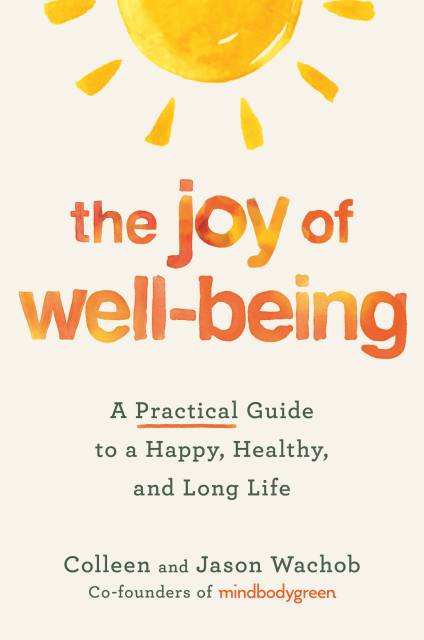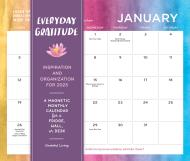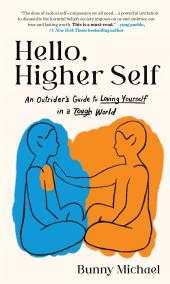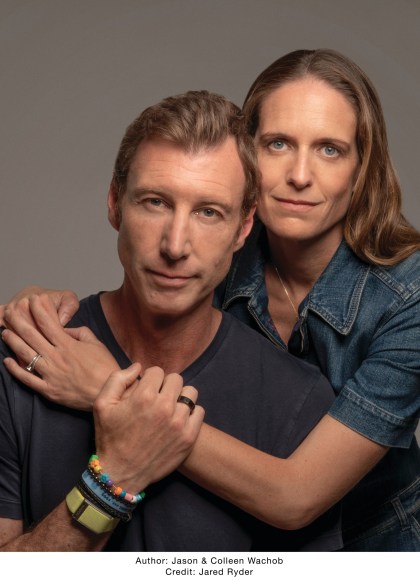By clicking “Accept,” you agree to the use of cookies and similar technologies on your device as set forth in our Cookie Policy and our Privacy Policy. Please note that certain cookies are essential for this website to function properly and do not require user consent to be deployed.
The Joy of Well-Being
A Practical Guide to a Happy, Healthy, and Long Life
Contributors
By Jason Wachob
Formats and Prices
Price
$29.00Price
$37.00 CADFormat
Format:
- Hardcover $29.00 $37.00 CAD
- ebook $12.99 $16.99 CAD
- Audiobook Download (Unabridged) $27.99
- Trade Paperback $21.99 $28.99 CAD
This item is a preorder. Your payment method will be charged immediately, and the product is expected to ship on or around May 23, 2023. This date is subject to change due to shipping delays beyond our control.
Also available from:
In this empowering and accessible collection of health and wellness advice, the co-founders of mindbodygreen challenge our definition of self-improvement by revealing what a healthy lifestyle looks like at the fundamental level—and how it’s not what we think.
On your journey toward a more health-conscious life, you’ve likely been bombarded by an overwhelming amount of information—from the Kardashian-like wellness influencers who (unrealistically) insist upon sustainably sourced Epsom salt baths every night, to the elite longevity optimizers who measure their lactate levels after a workout. The echo chamber of the internet, and social media algorithms that favor polarizing opinions to drive views and engagement, have hijacked our understanding of health. No matter which corner of the wellness world you inhabit, our social feeds are filled with advice that presumes we all have the same amount of time, money, and resources. In this saturated landscape, how can you avoid the potential scams and dodge the doctors-turned-celebrities to find what really works for you?
Over the past decade, Colleen and Jason Wachob, co-founders of mindbodygreen, have cultivated a leading wellness lifestyle media brand for everyone seeking to cut through this noise, and live a happier, healthier, and greener lifestyle. The Joy of Well-Being is a distillation of almost fifteen years of this experience on the forefront of the well-being conversation: they’ve done the legwork so you don’t have to. The book explores the spectrum of well-being, from how we breathe to how we love, including:
- Why sleep should be considered a vital sign
- Why you shouldn’t trick your body with food
- How to overcome the motivation problem and move more
- The importance of relationships for longevity
…and so much more.
The Wachobs are a product of their mentors and years of working with hundreds of the world’s most brilliant well-being minds, PhDs, MDs, therapists, movement specialists, spiritual leaders, and journalists. They’ve developed ways to discern meaningful points of information amidst the chaos, an act they consider both a science and an art. The Joy of Well-Being is more than a book, it’s a reawakening, marking a crucial shift away from the do-this-then-do-that paradigm, to cultivating a joyful lifestyle that centers each individual, and their own health and happiness. True well-being isn’t something you chase, it is something you weave together, as each new day presents an opportunity to make choices that support feeling good in your body, in your relationships, and in your life.
-
“A simple, inspiring guide to minding your mind, body, and spirit.”Deepak Chopra, MD, Spiritual Icon, New York Times Bestselling author
-
“Invite the Wachobs to guide you along the path to joy and well-being. They’re with you as you read, anticipating and answering your questions because they live on the deeply human level—taking you through their own personal and powerful journey to health. Cutting through the noise, Jason and Colleen share expert, evidenced-based input to inform each step toward wellness.”Lisa Miller, Ph.D., Author of New York Times bestsellers The Spiritual Child and The Awakened Brain; Professor and Founder, Spirituality Mind Body Institute, Columbia University
-
“There’s so much information about health and wellness—how do you know what’s right? In The Joy of Well-Being, the Wachobs have done the work so you don’t have to.”Mark Hyman, MD, Senior Advisor to the Cleveland Clinic Center for Functional Medicine, New York Times Bestselling author of Young Forever
-
“In The Joy of Well-Being, Colleen and Jason Wachob deliver the answers to timeless questions around health, happiness, and longevity that are revealed through their work with mindbodygreen. This book is a blueprint for how to use their knowledge to optimize your mental and physical well-being.”William W. Li, MD, NYT Times Bestselling author of Eat to Beat Your Diet and Eat to Beat Disease
-
“No overly complicated plans or routines. No extreme diets or fads. The Joy of Well-Being is a much-needed mindset shift towards prioritizing a way of living you actually enjoy.”Dan Buettner, National Geographic Fellow and #1 New York Times Bestselling author of the Blue Zones
-
"Jason and Colleen’s passion for helping people improve their wellbeing and live their best life is strongly evident in their new book, which clearly shows how joy and happiness is a key component of the well-being equation.”Caroline Leaf, PhD, Clinical neuroscientist and best-selling author
-
“Through mindbodygreen, the Wachobs have had unparalleled access to leading experts and information in the wellness world. In The Joy of Well-Being, they break it all down for you in a simplified way, so you don’t have to.”Frank Lipman, MD, NY Times Bestselling author
-
"Jason and Colleen’s take on wellness is filled with crucial insight into just how meaningful small, daily choices can be. It’s a guide to living well, without the rigidity and dogmatism we’re made to believe is necessary for a life well lived."Naomi Watts, Oscar Nominated Actress and Founder of Stripes
-
“Written with understanding and warmth, the Wachobs know how challenging it can be to live well in a time of information overload. Their solution has crucial insight: we can use small but meaningful daily choices to make ourselves happier and healthier”Amy Shah, MD, Double Board Certified MD & Bestselling author of I'm So Effing Hungry
-
“Colleen and Jason Wachob offer a new, highly accessible approach to achieving health and happiness.”Bobbi Brown, Entrepreneur and Founder of Jones Road Beauty
-
“The Joy of Well-Being is a fantastic guide for anyone looking to optimize their health routine without wasting their time or resources.”Troy Aikman, Pro Football Hall of Fame Quarterback, Founder of EIGHT Beer
-
“Deeply practical, The Joy of Well-Being cuts through the noise, and provides the tools and information needed to redefine your own sense of what it means to live well.”Sara Gottfried MD, New York Times Bestselling author of The Hormone Cure
-
"Achieving well-being and deeply enjoying our life experience absolutely should not be looked upon as a labor. Colleen and Jason Wachob lovingly provide the tools to enable each of us the opportunity to fill our sails with joy and contentment as we pursue these sought after and at times elusive goals."David Perlmutter, MD, FACN, Author, #1 New York Times bestseller Grain Brain, and Drop Acid
-
“What I love about The Joy of Well-Being is that it meets you where you are. The Wachobs know that well-being will look different for everyone, and the beauty of this book is that it doesn’t just accept this fact, it encourages it.”Maya Feller MS, RD, CDN and author of Eating from Our Roots
-
“An important resource for anyone who is frustrated with the current wellness world, and the overwhelming amount of information offered as a solution. The Joy of Well-Being will simplify your health journey, and what it means to be happy. What the Wachobs provide to the space is unparalleled.”Gabrielle Lyon, DO, Founder, Institute of Muscle Centric Medicine®
-
"I'm so excited that Jason and Colleen have pulled together their decades of experiences, having created one of the world's most influential wellness platforms, into a concise, smart guide of inspiring solutions to fuel everyone's quest for optimal, joyful health! The Joy of Well-Being is an amazing resource with the ultimate mindset shift that the world needs right now."Vincent Pedre, MD, "America's Gut Doctor," author of The GutSMART Protocol
-
"If you are tired of happiness “hacks” and are ready to do the work to improve your life satisfaction, The Joy of Well-Being was written for you. Colleen and Jason Wachob distill a wealth of science into a delightful guide we all can follow."Arthur C. Brooks, Professor, Harvard Kennedy School and Harvard Business School, and #1 New York Times bestselling author
-
"Joy is what we all want. I have seen some of the world’s most famous people, and uniformly they want more joy, as fame and the current American lifestyle has robbed them of it. If you want to feel more joy, more vibrancy, and more energy read The Joy of Well-Being by Colleen and Jason Wachob, who have dedicated their lives to sharing this powerful message."Daniel G. Amen, MD Founder, Amen Clinics and author of Change Your Brain Every Day
- On Sale
- May 23, 2023
- Page Count
- 288 pages
- Publisher
- Balance
- ISBN-13
- 9781538724828
Newsletter Signup
By clicking ‘Sign Up,’ I acknowledge that I have read and agree to Hachette Book Group’s Privacy Policy and Terms of Use








